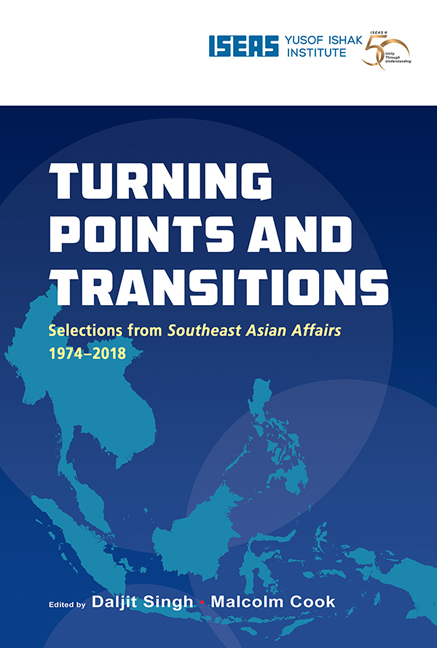Book contents
- Frontmatter
- Contents
- Message from the Director
- Foreword
- Foreword
- Introduction
- THE REGION
- BRUNEI
- CAMBODIA
- INDONESIA
- LAOS
- MALAYSIA
- MYANMAR
- THE PHILIPPINES
- SINGAPORE
- Singapore's Foreign Policy in the Seventies: The Reconciliation of Global and Regional Interests (1974)
- The Downturn in the Singapore Economy: Problems, Prospects and Possibilities for Recovery (1986)
- A Return to Normal Politics: Singapore General Elections 2011 (2012)
- THAILAND
- VIETNAM
The Downturn in the Singapore Economy: Problems, Prospects and Possibilities for Recovery (1986)
from SINGAPORE
Published online by Cambridge University Press: 29 May 2019
- Frontmatter
- Contents
- Message from the Director
- Foreword
- Foreword
- Introduction
- THE REGION
- BRUNEI
- CAMBODIA
- INDONESIA
- LAOS
- MALAYSIA
- MYANMAR
- THE PHILIPPINES
- SINGAPORE
- Singapore's Foreign Policy in the Seventies: The Reconciliation of Global and Regional Interests (1974)
- The Downturn in the Singapore Economy: Problems, Prospects and Possibilities for Recovery (1986)
- A Return to Normal Politics: Singapore General Elections 2011 (2012)
- THAILAND
- VIETNAM
Summary
Our economy is in the process of transforming itself from a low-wage, low productivity regime to a high-wage, highproductivity regime. The process is well under way.…
We are like a man on a flying trapeze, who has let go of one swing and is now sailing through mid-air. He cannot stop now. He must make it to the next swing if he is to recover safely. In the same way, we too have no choice but to press on with our economic restructuring (Straits Times, 27 July 1985, p. l).
The above remarks were made by the then Minister of State for Trade and Industry, and head of the government-appointed Economic Committee, in connection with a sharp downturn in the Singapore economy. They reflected the government's perception of the acute precariousness of the city-state's economic position. The rate of economic growth declined from 8.2 per cent in 1984 to −1.7 per cent in 1985. Domestic demand declined by 3 per cent and trade also contracted by 4 per cent during the year. A total of 90,000 jobs were lost and the unemployment rate had risen to 6 per cent at the end of the year. Observers also expect that the depressed economic conditions would continue over the next two to three years.
In the course of 1985, the government introduced several measures in an attempt to steer the economy back on to its original course. That course had been set earlier when the government announced its strategy for economic re-structuring in 1979. That strategy was intended to promote a general upgrading of the economy, so as to move out of low-wage, labour-intensive activities and into skill- and higher technologyintensive activities in manufacturing and services. It was believed that the latter activities would be capable of sustaining higher wages for the work-force, and would also be less vulnerable to trade competition and protectionist restrictions. Consequently, it was believed that Singapore would be less likely to encounter economic difficulties.
Why then did the strategy “fail” to avoid the present economic difficulties? Was it due to some unforeseen and unavoidable circumstances, or could the cause be attributed to some inherent aspects of the strategy itself? What are the prospects for a viable and sustained economic recovery?
- Type
- Chapter
- Information
- Turning Points and TransitionsSelections from Southeast Asian Affairs 1974-2018, pp. 601 - 621Publisher: ISEAS–Yusof Ishak InstitutePrint publication year: 2018



